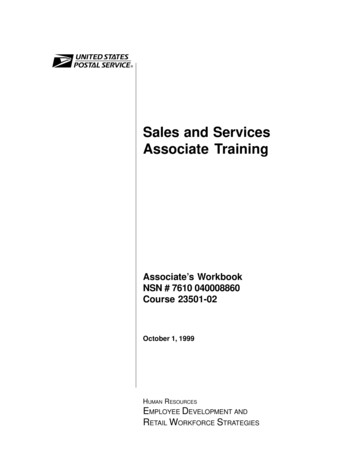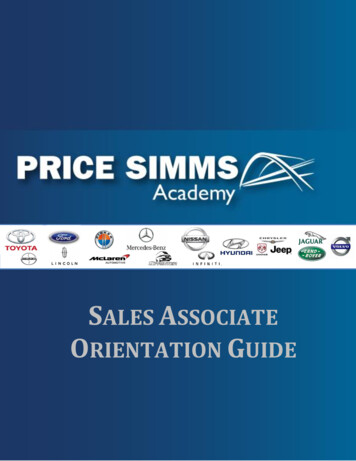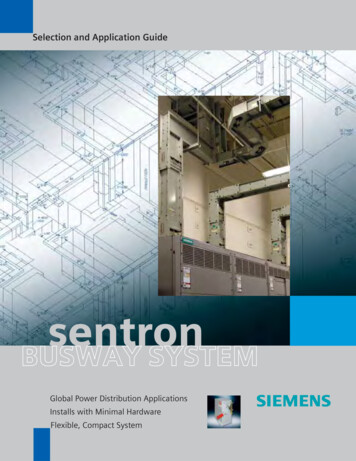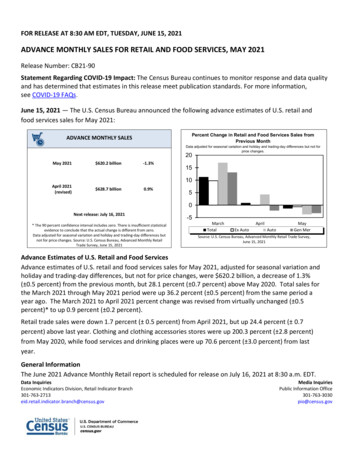
Transcription
Sales and ServicesAssociate TrainingAssociate’s WorkbookNSN # 7610 040008860Course 23501-02October 1, 1999HUMAN RESOURCESEMPLOYEE DEVELOPMENT ANDRETAIL WORKFORCE STRATEGIES
(This Page Intentionally Left Blank)
Sales and ServicesAssociate TrainingAssociate’s WorkbookNSN # 7610 040008860Course 23501-02October 1, 1999United States Postal ServiceHuman ResourcesEmployee Development and Retail Workforce Strategies475 L’Enfant Plaza SW
(This Page Intentionally Left Blank)IV
A COMMITMENT TO DIVERSITYThe Postal Service is committed to fostering and achieving a work andlearning environment that respects and values a diverse workforce. Valuingand managing diversity in the Postal Service means that we will build aninclusive environment that respects the uniqueness of every individual andencourages the contributions, experiences and perspectives of all people.It is essential that our work and learning environments be free from discrimination and harassment on any basis.In our classrooms, on the workroom floor, in casual conversation and informal meetings, employees and faculty are asked to encourage an openlearning environment that is supportive to everyone.Course materials and lectures, classroom debates and casual conversationshould always reflect the commitment to safety and freedom from discrimination, sexual harassment and harassment on any prohibited basis.Instructors have a professional obligation to provide a safe, discriminationfree and sexual harassment free learning environment.Class participants are asked to support zero tolerance of behavior thatviolates these commitments.If you find course material that is presented in the classroom or in selfinstructional format that does not follow these guidelines, please let aninstructor know immediately.If classroom discussions do not support these principles, please point thatout to the instructor as well.Diversity is a source of strength for our organization. Diversity promotesinnovation, creativity, productivity and growth, and enables a broadening ofexisting concepts.The Postal Service’s policy is to value the diversity of our employees,customers and suppliers; to do what is right for our employees and thecommunities we serve, thereby ensuring a competitive advantage in theglobal marketplace.V
(This Page Intentionally Left Blank)VI
Use of Training MaterialsThese training course materials are intended to be used for training purposes only. They have beenprepared in conformance with existing USPS policies and standards and do not represent theestablishment of new regulations or policies.This course material was produced in cooperation with Retail Workforce Strategies, EmployeeDevelopment and the American Postal Workers Union.Copyright 1999 by Employee DevelopmentUnited States Postal Service, Washington, DC 20260-4215All rights reserved.No part of this publication may be reproduced in any form or by any means without permission, inwriting, from Employee Development.Certain parts of this publication may contain copyrighted materials from other sources the reproduction of which for this specific training use has been interpreted not to exceed the fair use clauseof the copyright regulation (Ref. 371.5 ASM).VII
(This Page Intentionally Left Blank)
PREFACEThe Sales and Services Associate Training for Sales and Services Associates is theresult of a Labor/Management Team’s efforts to improve training for Sales andServices Associates. The team consisted of field managers, supervisors, clerks andrepresentatives of the American Postal Workers Union (APWU).This course is designed to provide PS-5 Sales and Services Associates with the basicskills and knowledge to perform the duties of their positions and provide Sales andServices Associates with refresher training.
(This Page Intentionally Left Blank)
ContentsDAY 1Module 1Module 2Module 3AModule 3BModule 3CModule 3DModule 4Module 5Sales and Services AssociatesDirectivesIRT (Unisys)IRT (MOS)POS ONE - NCRPOS ONE - IBMDomestic MailCredit/Debit Card ProgramDay One Review192733537389107115123DAY 2Module 6Module 7Module 8Module 9Customer RelationsInternational MailEstablishing a Fixed CreditReturn Receipt, Restricted Delivery,Return Receipt for Merchandise andCertificate of MailingCertified MailRegistered MailDay Two Review129137149157165177185Module 10Module 11DAY 3Module 12Module 13Module 14Module 15Module 16Module 17ImageInsured MailCollect on Delivery (COD) MailExpress MailPO Box ServiceMoney OrdersDay Three Review193201209217225233241DAY 4Module 18Module 19Module 20Module 21Module 22Module 23Module 24Postal ProductsSecurity and Sanctity of MailDelivery ConfirmationClaims and InquiriesPublic Service AgenciesHow to Handle Irate CustomersUnion ModuleDay Four Review249255261281287293299313DAY 5Module 25Module 26Overview of Customer RelationsDaily Financial ReportCourse ReviewFirst Exam319325339345
(This Page Intentionally Left Blank)
Day One
(This Page Intentionally Left Blank)
IntroductionTerminal ObjectiveUpon conclusion of this section, future Associates will be able to provide anoverview of this course’s content and teaching methodology.Enabling Objectives:Upon conclusion of this section, future Associates will be able to: Explain course content Explain teaching methodologies Identify administrative issues
Presentation1.Complete your name tent card, and introduce yourself.2.Form pairs and interview each other for five minutes (name, hometown,interests).3.Administrative matters. Class and Break Times Smoking Policy Facility Arrangements Refreshments Rest Rooms Fire Exits Medical Facilities Dress Code Emergency Plans4.This training program consists of classroom instruction and learningexperiences that actively engage the future Associates through adult learningtechniques such as; role-playing, hands-on simulations, etc. This will be followedby Structured On-the-Job Training (SOJT). A pretest will be given at the end ofthe classroom section, then a final test and evaluation after the Structured Onthe-Job Training.5.The classroom instruction will involve presentations, demonstrations, shortreading assignments, discussions, hands-on practice, role-playing, and variousother exercises to help you relate the concepts you are learning to what you willdo on the job. The SOJT is specific to each type of transaction. This one-on-onetraining is conducted in a station or branch within your district.6.Guest speakers may address the class regarding their areas of expertise.
(This Page Intentionally Left Blank)
(This Page Intentionally Left Blank)
Module 1:Sales and ServicesAssociates
Course # 23501-02(This Page Intentionally Left Blank)20Module 1: Sales and Services Associates
Sales and Services Associate TrainingModule 1: Sales and Services AssociatesTerminal ObjectiveUpon conclusion of this module, future Associates will be able to describe their rolesand responsibilities as Sales and Services Associates.Enabling Objectives:Upon conclusion of this module, future Associates will be able to: Identify and explain their roles and responsibilities as Sales and ServicesAssociates.Associate’s Workbook21
Course # 23501-02PRESENTATIONThere’s a saying that goes like this:It’s not what you say, but what is heard.It’s not what you show, but what is seen.It’s not what you mean, but what is understood.PERCEPTION IS REALITY.In today’s competitive marketplace, customer perceptions are especially important.Sales and Services Associates have a unique opportunity to positively influencecustomer perceptions of the Postal Service. The public’s perception of the PostalService is mostly shaped by what it sees. Sales and Services Associates are theprimary contact people have with the Postal Service.22Module 1: Sales and Services Associates
Sales and Services Associate TrainingExhibit 1Associate’s Workbook23
Course # 23501-02Exhibit 2STD Position Description(Draft) Position DescriptionU.S. Postal ServiceSales and Services Associate, PS-05Functional PurposePerforms a variety of sales and customer support services for products. Maintains pleasant and effectivepublic relations with customers and others requiring a general familiarity with postal laws, regulations,and procedures commonly used.Duties and Responsibilities1. Performs any variety of sales and customer services at a retail window such as maintainingsufficient inventory of and selling stamps, stamped paper, other retail products and services andmay use a computerized system, accepting and delivering packages and accountable mail; issuingand cashing foreign and domestic postal money orders; accepting and responding to customerclaims and inquiries, and providing information to the public regarding postal regulations.2. Provides sales and customer service support by greeting customers and explaining store layou;determining special interests and referring to sales and promotional programs; offers assistance inproduct selection; provides special assistance; and answers customer inquiries when needed.3. Provides product and service information to customers, including informing customers regardingspecial offers; suggestive selling related merchandise; promoting products based on customerneeds. Provides additional information regarding product features and services.4. Handles and processes customer purchases and returns relating to products and services and mayuse a point of sale system. Assists customers with transactions.5. Maintains appearance of store by setting up, arranging, and replenishing displays and merchandiseracks; ensures display and selling areas, work stations, and storage areas are presentable tocustomers.6. Conducts product inventories by counting items on hand; attaches and removes security devices;accounts for items on display; and verifies and records sales floor inventory and shrinkage. Bringsinventory discrepancies and shrinkage reports to the attention of the appropriate supervisorypresence.7. May verify presort and bulk mailings of all classifications, computing and maintaing on a currentbasis mailer’s credit balances.8. Checks and sets post office stamp-vending machines and postage meters.24Module 1: Sales and Services Associates
Sales and Services Associate Training9. Rents post office boxes, receives rental payments, conducts reference checks, and completesrelated forms.10. In addition, may assign and clear accountable items and distribute mail as required; and otherduties as assigned.SUPERVISIORSupervisor, Customer Services, or other supervisor/designeeSELECTION METHODBARGAINING UNITClerkAssociate’s Workbook25
(This Page Intentionally Left Blank)
Module 2:Directives
Course # 23501-02(This Page Intentionally Left Blank)28Module 2: Directives
Sales and Services Associate TrainingModule 2: DirectivesTerminal ObjectiveUpon completion of this module, future Associates will demonstrate how to use thedirectives system to locate information on postal products and services.Enabling Objectives:Upon completion of this module, future Associates will be able to identify anddemonstrate how to use USPS directives, including manuals, handbooks, postalbulletins and publications for Sales and Services Associates’ use.Associate’s Workbook29
Course # 23501-02PRESENTATION Manuals (contain the basic policies and instructions of the Postal Service.)DMM – DOMESTIC MAIL MANUALIMM – INTERNATIONAL MAIL MANUALASM – ADMINISTRATIVE SUPPORT MANUALPOM – POSTAL OPERATIONS MANUALF-1– FINANCIAL HANDBOOK Postal BulletinsCurrent (temporary) instructions and fast issuance of permanent directives are tobe placed into appropriate manuals when updated versions are reprinted andreleased. It contains missing money order list that must be checked prior tocashing any postal money order. This is published bi-weekly.Additional information such as stamp information, invalid corporate accounts,and references to military mail information can also be found in the PostalBulletin. Handbooks and PublicationsSpecialized instructions, reference works, training materials, procedures, andbrochures that are too specialized, intended for a particular audience orotherwise inappropriate for inclusion in manuals (e.g., Mailers Companion, andPub 32 Glossary of Postal Terms).30Module 2: Directives
Sales and Services Associate TrainingExercisesMatch the directive with the appropriate descriptiona.Domestic Mail Manual (DMM)b.International Mail Manual (IMM)c.Postal Bulletind.None of the aboveThis manual provides information on acceptance of and mailingrequirements for non-domestic mail.Current instructions and fast issuance of permanent directives to beplaced into appropriate manual when updated.This manual includes information on the postal organization, inspectionservice, communications, records and release of information, marketing,procurement, and computer-based info systems.This manual contains rules, regulations and instructions regarding thepostal services and classes and types of mail. It also includes internal operatingprocedures, but these procedures are also included in the subject manuals andhandbooks.Use the directives to list references for the following:1.Definition of a letter2.Cashing money orders3.Claims for refunds4.What may be insured5.Can a person mail jewelry to South America6.Address elementsAssociate’s Workbook31
(This Page Intentionally Left Blank)
Module 3A:IRT (Unisys)
Course # 23501-02(This Page Intentionally Left Blank)34Module 3A: IRT (Unisys)
Sales and Services Associate TrainingModule 3A: IRT (Unisys)Terminal ObjectiveUpon the conclusion of this module, future Associates will demonstrate basic IRT skillsnecessary to conduct transactions and to complete the final daily clerk report(PS1412A).Enabling Objectives:Upon the completion of this module, future Associates will be able to: Demonstrate safety practices and procedures. Explain the function of each IRT component. Explain action to be taken in case of component system failure. Identify different key groups/special keys. Demonstrate proper handling of diskettes. Demonstrate IRT/PVI start-up procedures log on IDAssociate’s Workbook35
Course # 23501-02PRESENTATION:The Integrated Retail Terminal (IRT)The IRT is a disk driven computer-type system (it is not a PC) that will automaticallycalculate and display postage and ATD fees for you. The appropriate rates and feesare stored in the memory on the IRT disk. The IRT is not an “on-line” system in that it isnot attached to a network. Therefore, any updates to information (such as new rates orregulations) are accomplished via diskette.The IRT provides: Automatic entry of amounts in the proper Account Identifier Code (AIC)through dedicated keys. Automatic local express mail network and directory information. Automatic building of express mail label lists. Automatic building of Delivery Confirmation list. Automatic entry of money order fees. Automatic entry of permit fees. Automatic building of domestic money order list. Automatic building of check list. Automatic conversion of ZIP code to postal zone. Automatic calculation of domestic and international postal rates. Consolidation of clerk’s PS Form 1412A to the Unit 1412. Consolidation of clerk’s lists. Conversion of express mail data to Scanner database. Conversion of Delivery Confirmation to database. System-generated PS Forms 3544 and 3603.Benefits of the IRTThe IRT allows the Sales and Services Associate to handle customer business withgreater efficiency. The design of the IRT provides the Sales and Services Associateand customer with many benefits.Sales and Services Associate Benefits: Perform multiple customer transactions and keep a running total of theamount due. Automatically calculate the amount of change due the customer. Perform standardized transactions. Reduce mathematical errors. Record the complete day’s business. Produce a system-generated PS Form 1412A, eliminating the need for amanual PS Form 1412A and the time it would take to prepare it. Produce system-generated receipts versus manual receipts.36Module 3A: IRT (Unisys)
Sales and Services Associate TrainingCustomer Benefits See transactions on customer monitor. Receive automated receipts. Receive faster, accurate, and more efficient service.System ComponentsThe hardware components that make up the IRT include: Keyboard Central Processing Unit (CPU) Disk Drive Scale Clerk Display Screen Customer Display Screen Bar Code Reader Wand Customer Receipt/Report PrinterThe Keyboard is used to enter the selected function into the IRT. The keyboard isthe communication link between you, the user, and the IRT. The IRT system carriesout a particular command only after the user has provided keyboard input. The IRTresponds to the keyboard input by performing the requested function or byprompting for more specific instructions.The Scale is combined with the CPU and used to automatically calculate the weight ofan article and enter it into the IRT. The weight and the amount due is displayed for thecustomer and the future Associate.The Clerk Display Screen (the large 12” screen) displays to the future Associate thedata pertaining to the selected function along with instructions for that particularfunction.The Customer Display Screen (the small 7” screen) displays to the customer thesame information that is displayed on the future Associate display screen.The Bar Code Reader Wand is hand held and used to scan (read) into the IRT theexpress mail label number or delivery confirmation, and is also able to scan (read)the bar code on money order packets when performing the money order set upfunction. Future postal products and services will feature bar codes that this readerwand will use to scan (read) into the IRT.The Receipt/Report Printer prints a receipt for the customer and prints reports andlists for the future Associate.Associate’s Workbook37
Course # 23501-02The Keyboard is divided into four distinct functional groupings, with color coding foreasy recognition. The functional groupings are: Accounting Postal rate Keyboard Control/Support Keys Numeric/CalculatorMost of the keys on the IRT keyboard are dedicated function keys. This means theyaccess specific functions, such as post office to addressee express mail, or postagesales. Other keys, such as the shift key, provide support to other major functions.The keys in the top three rows also contain lights. Some of these keys light up whena key has been pressed as part of a transaction. Others flash as a reminder to pressa key or make a selection.The four keyboard function groups and the purposes of each are described asfollows:Accounting KeysThe accounting function keys (most of which are white; five are red) are located onthe bottom four rows of keys— the two exceptions being the white MISC postagekey, on the top row, second from right side, and the red start of day key located onthe top row, upper right corner of the keyboard. These keys are called accountingfunction keys because the functions they access keep track of the receipt ordisbursement of money exchange for goods or services.Certain accounting keys serve administrative accounting purposes, such as settingup money orders or correcting errors. Most of the accounting keys, however, areused to process funds received or disbursed. Most of the keys in the accountingsection are dedicated keys. In general, pressing these keys causes the system toprompt for an entry to be made by the Sales and Services Associate (i.e., an amount ora serial number).White Accounting Keys (Explain and Demonstrate)Red Accounting Keys (Explain and Demonstrate)38Module 3A: IRT (Unisys)
Sales and Services Associate TrainingPostal Rate KeysPostal rate keys include the domestic, international, and express mail functions as wellas their special services. The color of the postal rate keys is either gray (for domesticmail classes and for special services) or blue (for internatio
The Sales and Services Associate Training for Sales and Services Associates is the result of a Labor/Management Team’s efforts to improve training for Sales and . including manuals, handbooks, postal bulletins and publications for











